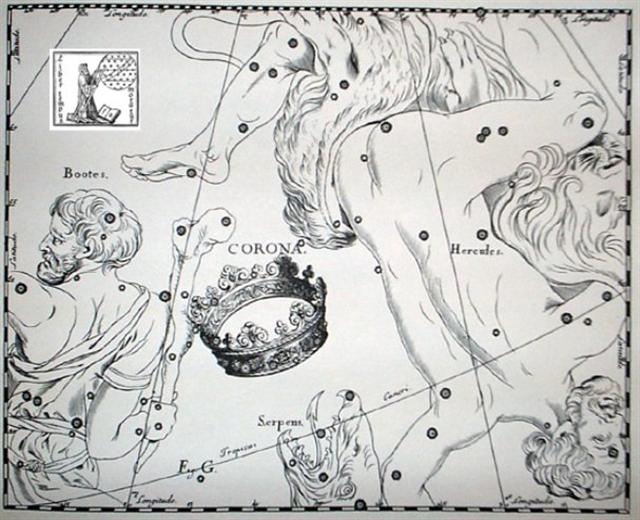Once again. I think the creator of the G text designed Gb2-16 and Gb6-20 in order to draw attention to the distance from Alnair to Sirius:
Possibly it was important that Gemma (α Corona Borealis) culminated at midnight in APRIL 25 (where 285 + 115 = 400): ... Sir James Frazer, like Gwion, has pointed out the similarity of 'door' words in all Indo-European languages and shown Janus to be a 'stout guardian of the door' with his head pointing in both directions. As usual, however, he does not press his argument far enough. Duir as the god of the oak month looks both ways because his post is at the turn of the year; which identifies him with the Oak-god Hercules who became the door-keeper of the Gods after his death. He is probably also to be identified with the British god Llyr of Lludd or Nudd, a god of the sea - i.e. a god of a sea-faring Bronze Age people - who was the 'father' of Creiddylad (Cordelia) an aspect of the White Goddess; for according to Geoffrey of Monmouth the grave of Llyr at Leicester was in a vault built in honour of Janus. Geoffrey writes: Cordelia obtaining the government of the Kingdom buried her father in a certain vault which she ordered to be made for him under the river Sore in Leicester (Leircester) and which had been built originally under the ground in honour of the god Janus. And here all the workmen of the city, upon the anniversary solemnity of that festival, used to begin their yearly labours. Since Llyr was a pre-Roman God this amounts to saying that he was two-headed, like Janus, and the patron of the New Year; but the Celtic year began in the summer, not in the winter. Geoffrey does not date the mourning festival but it is likely to have originally taken place at the end of June ... What I take for a reference to Llyr as Janus occurs in the closing paragraph of Merlin's prophecy to the heathen King Vortigern and his Druids, recorded by Geoffrey of Monmouth: After this Janus shall never have priests again. His door will be shut and remain concealed in Ariadne's crannies. In other words, the ancient Druidic religion based on the oak-cult will be swept away by Christianity and the door - the god Llyr - will languish forgotten in the Castle of Arianrhod, the Corona Borealis. This helps us to understand the relationship at Rome of Janus and the White Goddess Cardea who is ... the Goddess of Hinges who came to Rome from Alba Longa. She was the hinge on which the year swung - the ancient Latin, not the Etruscan year - and her importance as such is recorded in the Latin adjective cardinalis - as we say in English 'of cardinal importance - which was also applied to the four main winds; for winds were considered as under the sole direction of the Great Goddess until Classical times. As Cardea she ruled over the Celestial Hinge at the back of the North Wind around which, as Varro explains in his De Re Rustica, the mill-stone of the Universe revolves. This conception appears most plainly in the Norse Edda, where the giantesses Fenja and Menja, who turn the monstrous mill-stone Grotte in the cold polar night, stand for the White Goddess in her complementary moods of creation and destruction. Elsewhere in Norse mythology the Goddess is nine-fold: the nine giantesses who were joint-mothers of the hero Rig, alias Heimdall, the inventor of the Norse social system, similarly turned the cosmic mill ...
In rongorongo times the Woman in Chains (Andromeda) was at the northern spring equinox and her right chained hand, Manus Catenata (ι), rose with the Sun in March 14 (3-14) which was 108 (= 4 * 27) days before Sirius. March 11 (435) + 3 = 438 = 365 + 73 (3-14, π):
54 precessional days earlier than at the time of rongorongo Manus Catenata (*358) would have been in day 384 = 13 * 329˝ + ˝. *358 - 54 = *304 and *304 + 80 = 384 = 365 + 19.
Possibly the Woman in Chains inspired the creator of the G text to design chains at Sirius, keeping this star pillar standing straight in spite of the precessonal time flow ahead. Furthermore there was apparently a 7-day wake after the Oak Pillar - now forgotten in the Castle of Arianrhod: ... The month, which takes its name from Juppiter the oak-god, begins on June 10th and ends of July 7th. Midway comes St. John's Day, June 24th, the day on which the oak-king was sacrificially burned alive. The Celtic year was divided into two halves with the second half beginning in July, apparently after a seven-day wake, or funeral feast, in the oak-king's honour ...
Counted from culminating Gemma (Arianrhod) there were 7 days up to and including July 4 (185), when Nunki was at the Full Moon. ... Close to the Full Moon were Ascella and Nunki in Sagittarius, which meant that when Sirius was at the Sun then the Full Moon would had been where the Sea was said to begin. At the time of Gregory XIII this was in day 364 counted from °January 1. Land was beginning in °June 30 and its opposite, Sea, was originating in °December 31 ...
Gb6-25 was drawn exactly as Gb6-17 and possibly it means we should jump 7 days beyond Sirius to Wasat, past July 7.
|
||||||||||||||||||||||||||||||||||||||||||||||||||||||||||||||||||||||||||||||||||||||||||||||||||||||||||||||||||||||||||||||||||||||||||||||||||||||||||||||||||||||||||||||||||||||||||||||||||||||||||||||||||||||||||||||||||||||||||||||||||||||||||||||||||||




















